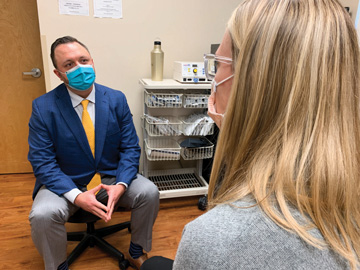Medications used as part of a multimodal pain management plan must be prescribed based on the specific needs of individual patients and precisely timed, meaning patient education is a key component of any non-opioid pain protocol program, says
Dr. Moutzouros. He suggests discharging patients with a dosing grid that breaks down their post-op treatment protocol day by day and hour by hour, so they know exactly which medications to take and when to take them.
The grid can include a gradual reduction in the dosing of the medications to help patients wean themselves off the treatments, if possible, after about five days. Give the grid to patients and their family members before scheduled procedures and
explain each step of the dosing regimen as well as the importance of timing the medications correctly. This way, they’ll have a chance to digest the information and ask questions before they arrive for surgery.
“It’s easy to give a single medication and tell patients to use it as needed instead of four different therapies that need to be scheduled and timed appropriately,” says Dr. Moutzouros. “Multimodal medication regimens are
more intensive, but they’re worth implementing in order to not expose patients to opioids unnecessarily.”
It’s also crucial to consider how to best treat patients who regularly take opioids to treat chronic pain and often have a harder time dealing with discomfort in the postoperative setting, according to Dr. Goins. “For this patient
population, it’s recommended to decrease or eliminate the use of daily opioid medications prior to elective surgery,” she says. “Chronic opioid use is known to amplify pain signals. Minimizing this effect preoperatively will
decrease the need for opioids postoperatively.”
Dr. Goins points to the importance of involving all members of a patient’s care team — primary care physician, surgeon, anesthesiologist, pain specialist — in creating a pain management plan for the perioperative period as well
as contingency plans for emergent needs. These coordinated efforts often eliminate worry and frustration for both patients and providers.
Patients like having a non-opioid pain management protocol as an option in their care plan. “We’ve found that many patients or their caregivers sought out the non-opioid protocol to avoid the side effects and risks associated with
narcotics when they found out it was an option,” says Dr. Moutzouros.
Because non-opioid pain management has the potential to improve outcomes and increase patient satisfaction, many other specialties are looking to it as an option to keep patients pain-free and happy. “All surgeries are potentially amenable
to reduced doses or no opioid use postoperatively, depending on the surgical technique, use of regional anesthesia, the ability to maximize non-opioid medications and the individual patient’s underlying medical conditions,” says
Dr. Goins. “Balancing all these factors helps us create an optimal pain management plan that’s tailored to each patient.”
Orlando Health, a hospital system in Central Florida, recently conducted a national survery that found 80% of respondents believe opioids are needed to manage post-op pain. Although 65% of the respondents were more worried about managing their
post-op pain than the risk of becoming addicted to opioids, 68% said they would be interested in trying alternative opioid-free therapies.
“When I talk to patients and reassure them that we’re going to be replacing opioids with a much more effective and safe method, and talk to them about the risks of opioids that have become much more evident with the research that’s
come out recently, most patients are very open to the idea,” says Luke Elms, MD, a general surgeon at Orlando Health Dr. P. Phillips Hospital.
He has developed a non-opioid post-op pain management protocol based on the use of acetaminophen, ibuprofen and muscle relaxers, which he says in combination provide targeted and powerful pain relief.
“It’s very important to keep in mind that surgical patients do have pain and need pain control. The solution is not to pull opioids away and leave them to fend for themselves,” says Dr. Elms. “This is a real problem after
surgery that needs to be addressed in a compassionate manner.” OSM
.svg?sfvrsn=be606e78_3)

.svg?sfvrsn=56b2f850_5)